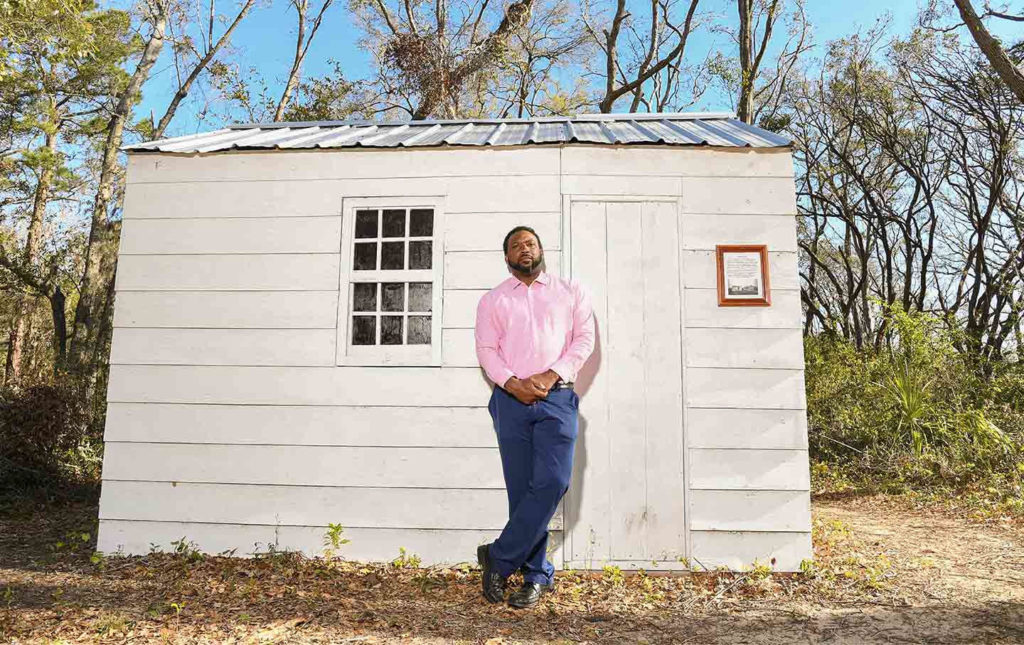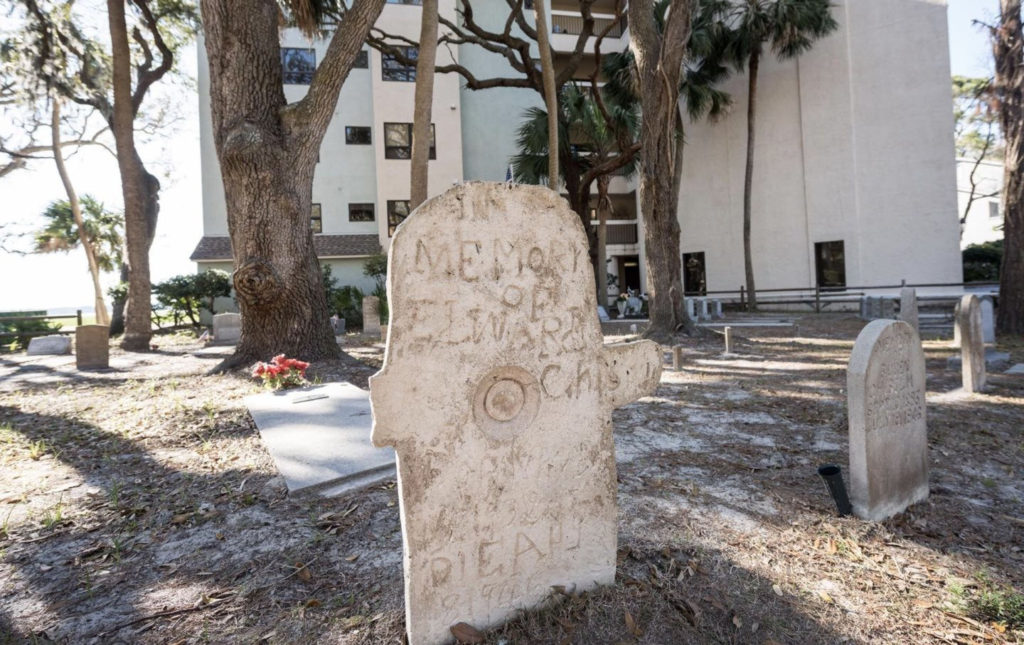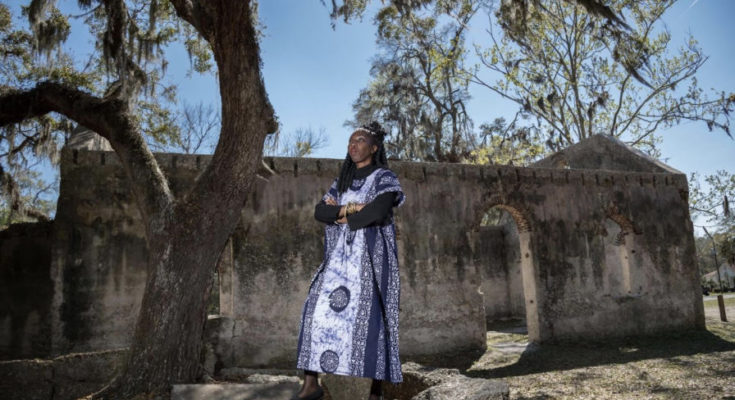Driving the long, flat roads of Hilton Head Island is hypnotic. One bike-rental shop blends into another; countless villa-style office complexes advertise real-estate agents and banks. Tourists meander to their cars wearing all white, carrying brightly colored smoothies. Rows of palm trees wave slowly over the crawling traffic. A waterfront hotel looms on the horizon.
Along Allen Road, though, an older version of Hilton Head is preserved. The short street bisects a 38-acre plot and travels past some 23 trailers that house members of the Allen family. Tall oak and pine trees block the sun from flowering shrubs in the sandy soil. The noise from passing cars is drowned out by bird chatter and an occasional shout from one family member to another.
Matthew Allen, now in his 70s, grew up visiting this family land where his father and grandfather grew up. “When [my father] was coming up,” he recalls, “they used to…go down to the water to fish. They used to hunt. [They] used to farm the land, used to grow okra, corn, sweet potatoes. They took full advantage of the land.”
It was Dennis Allen, Matthew’s great-grandfather, who purchased the land on Hilton Head. The son of slaves, Dennis Allen bought his first parcel of nearly 20 acres in 1897, at a time when African Americans were purchasing land across the country. Today, the Allen family owns the largest undeveloped lot on Hilton Head.
But as the land enters its 120th year in the family, the Allens are struggling to hold on to it. Because of ambiguities surrounding the land’s title, there is no primary owner of the property; all of the heirs of the original owners—and there are more than 100 known heirs—are legally co-owners. As such, the land is classified as “heirs’ property,” a designation that makes it vulnerable to being sold without the family’s full consent. As the Allens attempt to overcome a stacked legal system—exacerbated by corrupt lawyers and predatory developers—they are at the center of a decades-long fight to retain black-owned land across the South.
In the 45 years following the Civil War, freed slaves and their descendants accumulated roughly 15 million acres of land across the United States, most of it in the South. Land ownership meant stability and opportunity for black families, a shot at upward mobility and economic security for future generations. The hard-won property was generally used for farming, the primary occupation of most Southern blacks in the early 20th century. By 1920, there were 925,000 black-owned farms, representing about 14 percent of all farms in the United States.
Over the course of the 20th century, however, that number dropped precipitously. Millions of farmers of all races were pushed off their land in the early part of the century, including around 600,000 black farmers. By 1975, just 45,000 black-owned farms remained. “It was almost as if the earth was opening up and swallowing black farmers,” writes scholar Pete Daniel in his book Dispossession: Discrimination Against African American Farmers in the Age of Civil Rights. Implicit in the decline of black farming was the loss of the land those farmers once tilled. Today, African Americans compose less than 2 percent of the nation’s farmers and 1 percent of its rural landowners.
Many factors contributed to the loss of black-owned land during the 20th century, including systemic discrimination in lending by the US Department of Agriculture, the industrialization that lured workers into factories, and the Great Migration. But the lesser-known issue of heirs’ property also played a role, allowing untold thousands of acres to be forcibly bought out from under black rural families—often second-, third-, or fourth-generation landowners whose ancestors were enslaved—by real-estate developers and speculators.
By one estimate, 81 percent of these early black landowners didn’t make wills, largely due to a lack of access to legal resources. Their descendants then inherited the land without a clear title, and it thereby became designated as heirs’ property. Although heirs’ property exists in many regions of the country, it’s most prevalent in low-income communities. In the South, according to one estimate, more than 50 percent of heirs’-property owners are African-American, many of them the descendants of slaves and sharecroppers. The Center for Heirs’ Property Preservation, based in Charleston County, South Carolina, estimates that there are 105,000 acres of heirs’ property in its 15-county service area alone.
Without a clear title, heirs’-property owners are limited in what they can do with their land. They can’t get mortgages or do extensive repairs on their homes; as a consequence, some live in trailers. They aren’t eligible to apply for state or federal housing aid (such as funds provided by the Federal Emergency Management Agency) or for nearly any of the programs administered by the Department of Agriculture, including the crucial loans and conservation funding that keep many rural landowners afloat. “So [they’re] already hampered because [they] have heirs’ property,” explains Jennie L. Stephens, the executive director of the center, “but now [they’re] sitting here with these hundreds of acres, and [they] can’t do anything with it.”
As with the Allen family, heirs’ property is often jointly owned by many descendants, some of whom are scattered across the country and may never have met one another. Each has a claim to the land, but this type of joint ownership makes them vulnerable to a peculiar legal challenge: Any one of these co-owners has the legal right to sell their share of the property—or even to bring the whole parcel of land to court-ordered auction—without the consent of the others.
These “partition sales” are one cause of the dispossession crisis, according to the Heirs’ Property Retention Coalition. Property developers entice faraway relatives who may never have visited their family’s land to sell their share for a fraction of its market value. Once they buy a share, these developers can then sell all of the land at auction for a large profit. A 2001 report from the US Agricultural Census estimated that about 80 percent of black-owned farmland had disappeared in the South since 1969. Approximately half of that land was lost through partition sales.
Thomas W. Mitchell, an expert in heirs’ property at the Texas A&M University School of Law, says families will often try to fend off partition sales by arguing that their land is historically significant, or of cultural importance to the African-American community. But until recently, the courts weren’t legally required to take into account the historical or cultural value of the land, and so they generally don’t.
Mitchell attributes the persistent and ongoing issue of partition sales in the African-American community to a question of power, at least in part. “If the Kennedys, the Bushes, or the Clintons had their property sold under these circumstances,” he says, “the law would have been reformed” by now.

Living History: Alex Brown stands before a re-creation of an original Gullah house. (Richard Ellis)
Hilton Head, on the southeastern coast of South Carolina, is one of more than 100 coastal islands that form the Sea Islands. Though it is now primarily known as a golfing and resort destination, Hilton Head was once almost entirely inhabited by the Gullah people. The Gullah are descendants of enslaved West Africans who, like Dennis Allen, moved to the Sea Island region at the end of the Civil War, or who had previously been enslaved on area plantations. Gullah communities thrived for decades on the isolated islands, largely free of the restrictions of the Jim Crow South. For generations, they maintained an agricultural, barter-based economy.
Then, in the mid-1950s, development came to Hilton Head. Wealthy industrialists bought up hundreds of acres for recreational sites as highway and bridge construction made it easier for mainland residents to reach the islands. By the 1990s, the waterfront properties on Hilton Head had become highly desirable among wealthy whites seeking a vacation home.
The development displaced many Gullah people. Some families lost their land to rising property taxes, which they could no longer afford to pay, but others lost their land in partition sales, their property brought to auction by developers in forced sales or by partial owners convinced to sell it for a fraction of its value. In areas where the Gullah once made up 90 percent or more of the population, they account for as little as 10 percent today, according to Willie Heyward, managing attorney at the Heirs’ Property Law Firm. Somewhere between 200 and 700 acres of the land on Hilton Head—no one knows the exact number— remain in Gullah hands.
“The property that we owned was prime property,” says Alex Brown, a Gullah native and chair of the island’s planning commission. “Over time, it’s been sold and traded and stolen.” And because of the Gullah’s unique history of agricultural production, the loss of land amounts to a loss of culture.
“If we don’t have our land, we don’t have our family,” says Queen Quet, chieftess of the Gullah/Geechee Nation. “This is the battle we’re in now.”

The Braddock’s Point Cemetery, an historic Gullah burial ground now surrounded by Hilton Head’s Sea Pines resort. (Richard Ellis.)
On September 22, 2016, Nikki Haley, then governor of South Carolina, signed the Clementa C. Pinckney Uniform Partition of Heirs’ Property Act. The law, named for the revered state senator and pastor who was killed in the 2015 massacre at the Emanuel African Methodist Episcopal Church in Charleston, provides several protections for heirs’- property owners. If one co-tenant initiates a sale, for instance, the other co-tenants must be given an opportunity to buy that tenant’s share before the land can be sold. The act also requires judges to consider things like the sentimental, cultural, or historical significance of the land as well as its market value (previously the only consideration in most cases) before ruling to sell it. And if the land is sold, it must be sold on the open market instead of at auction, so that families receive a fair price. Josh Walden, the supervising attorney at the Center for Heirs’ Property Preservation, calls the act a “great tool” with the potential to preserve the land of many heirs’-property owners. Queen Quet calls it “a blessing.”
The law has its origins in model legislation that was written in 2010 by the Uniform Law Commission, which drafts bills for states to consider. Thomas W. Mitchell was its lead author—only the second African American in the history of the commission to serve as the lead author of a uniform law. He calls the act the “most significant reform to property law in the history of this country.” It has already been passed by 10 states, including Alabama, Connecticut, Montana, Nevada, New Mexico, and Texas, and was introduced in the District of Columbia earlier this year.
Beyond South Carolina, there is some evidence that black land ownership is on the rise. One 1999 study found that there were roughly 68,000 black agricultural landowners in the United States who owned more than 7.7 million acres, mostly in the South. The 2012 Census of Agriculture showed that the number of farms with black principal operators had risen 9 percent since 2007.
For some heirs’-property owners on the Sea Islands, the new law may prove seminal in protecting what land remains in the Gullah’s hands. For others, it comes too late. For the Allens, the law’s effect remains to be seen. While the family is cautiously optimistic, they would still need to bring a new lawsuit under the act, since it doesn’t apply retroactively to their existing case.
Ever since Judge Marvin H. Dukes III denied their motion to dismiss the case, the Allens have been in and out of court. Recently, Matthew Allen and his branch of the family presented a proposal outlining how family members could work together, without intervention from the courts, to solve their conflicts over the land. Meanwhile, the few family members who do want to sell have taken steps to appoint a receiver, who would manage the family’s affairs while the land is still in dispute. The majority of the Allen family’s members don’t want the receiver appointed.
Margarite Washington, Matthew Allen’s cousin, has lived on Allen Road her whole life. Behind her home is a small memorial, a two-foot cross with a few flowers planted around it. Nearly five years ago, her 8-year-old nephew was killed by a stray bullet on that spot. “If they take the land, we’ll lose all of this,” she says, motioning to the memorial. “We would be devastated. Where are we going to go?” (Leah Douglas)





